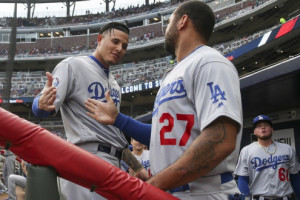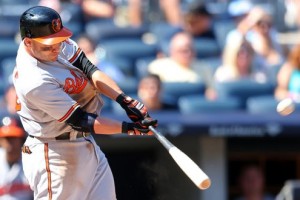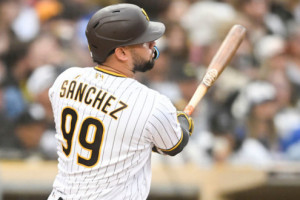Risers and Fallers: Volume 19
![]()
I’m back for another week of reviewing the most interesting players from the past seven days, pairing advanced metrics and insights from my DFS projection system, THE BAT, with my scouting background to try to figure out what to make of some the week’s most active lot of ballplayers.
Guys whose stock is going up, guys whose stock is going down, guys who are perpetually underpriced or overpriced, guys who are worth paying a premium for, or guys who are just interesting and warrant some analysis on.
UNDERRATED… AND UNDERPRICED
Matt Kemp, OF, Atlanta Braves
I’ve found myself playing Matt Kemp much more than I’d expect to lately, and as boring of a play as he is, there is undeniable value here. His DraftKings price tag has seriously deflated since being traded to the weak Braves offense, which of course plays half their games in an extreme pitchers’ park. But even on the road, like in Chase Field this week, Kemp is often very well priced, perhaps because of his platoon split. Touts will often say that you can’t play Kemp against right-handed pitching. After all, he’s hitting .242 with an ugly .299 wOBA vs. RHP this season, and his .316 wOBA vs. RHP last season wasn’t much better. But as I’ve said so many times before, right-hander platoon splits are incredibly noisy; note that in 2014, Kemp’s excellent .382 wOBA vs. RHP was significantly higher than his vs. LHP.

There’s no question that Kemp has one of the widest platoon splits of any right-hander in baseball; THE BAT has his vs. RHP/vs. LHP divide as the sixth largest among active hitters (Nelson Cruz and Franklin Gutierrez lead—no surprise). The issue, however, is one of severity. Actual platoon splits are exaggerated by the noise, and most believe the gap to be wider than it truly is. While Kemp is significantly worse against right-handers, that doesn’t mean he’s bad.
THE BAT projects his wOBA vs. RHP at .339 (which, coincidentally enough, is identical to his career mark), and the league average for righty-on-righty is .311. That actually means, despite the low mark this season, Kemp is a significantly above average hitter against right-handed pitching. So when you put him in a good park against a weak righty, and you price him in the low-to-mid-$3,000s on DraftKings, you wind up with a huge bargain and a low ownership to boot.
This was the case in Chase Field this past week, and I’m expecting it to be the case in Philadelphia this coming week. Citizens Bank is one of the best parks in baseball for righty power, and Kemp will face weak fly ball righties in Jeremy Hellickson and Vincent Velasquez plus a downright bad righty in Jake Thompson. If he continues to cost $3,500 on DraftKings, I’d have to think he’ll be one of the day’s better values.
Steve Pearce, 1B/2B, Baltimore Orioles
Pearce is another right-handed batter I absolutely love right now—even against right-handed pitching. He too has a wide platoon split, but he’s so good to begin with that he too is an above-average hitter against righties. Most don’t think of Pearce as anything more than an average or above-average hitter with some pop, but Pearce is downright good. He had a down season last year with a weak .308 wOBA that put a bad taste in some peoples’ mouths and created some negative associations. A huge part of that down year, though, was an unlucky .232 BABIP.
Take a look at Pearce’s wOBA over the past four years: .345, .404, .308, .370. Despite a track record of being excellent—apart from some awful, prolonged BABIP luck—the perception of Pearce simply hasn’t rebounded. He’s a power-hitter that can only be used against lefties. Except no.
Yes, a big part of Pearce’s game is power, but he strikes out at a slightly below-average clip, draws walks, and hits the ball hard. He posted a 17% HR/FB while playing half his games in homer-depressing Tropicana Field earlier this year. Now he’s a member of the Orioles and gets to play his home games in Camden Yards. And he’s frequently been hitting second for the Orioles. And he qualifies at second base on DraftKings. And he has cost under $3,000 the past few days. He’s less usable on FanDuel, where he only qualifies at first base and costs roughly the same amount, but this is a good player.

Pearce projects for an underlying .355 wOBA. You know who has a .355 wOBA this season? Mike Napoli. Xander Bogaerts. George Springer. Danny Valencia. That’s the caliber of hitter that Pearce is.
Over his career, Pearce has a .042 point gap between his wOBA against lefties and his wOBA against righties. It’s a fairly wide gap, but it’s not the huge one most people seem to think it is. So while you prefer him against lefties, like Kemp, he’s still a great play against weak righties, especially now in Camden Yards at a discount.
Andrew Triggs, SP, Oakland A’s
I’ve heard very little hype around Triggs, but this is a guy I’m falling in love with. He was claimed off waivers by the A’s this winter, having spent his entire minor league career as a reliever. Now, given Oakland’s complete lack of rotation options, Triggs has made five starts, and damn does this kid have a future.
Triggs looked the part of a reliever because of his low arm angle and sinker/slider mix. That’s a typical combination for a righty-specialist. But I see him as more than that, and it seems like Oakland does, too. As it stands, numerically, his platoon split hasn’t been nearly as large as you’d expect. Let’s talk about the stuff, though. The sinker/slider combo itself is pretty lethal. The sinker comes in at 92 with a lot of run. The slider has a big velocity differential at 77-mph that breaks hard in the opposite direction; it’s easily a plus pitch. In between the two is a cutter, which is a great pitch for helping to neutralize lefties as it generally holds a smaller platoon split. This year, to further help against lefties, he’s added a change-up. He uses it infrequently, but it too has flashed plus when he’s used it. As he begins to work it in more, he could be truly great. The sinker generates lots of ground balls, the slider generates strikeouts, and his control is excellent.
His biggest issues are ones he can’t control. He’s a ground ball pitcher that pitches in front of the game’s worst infield defense. Ground ball pitchers give up more hits to begin with, and ones that don’t have their double-play balls turn into double plays can have things spiral out of control quickly. Further hurting Triggs is having to throw most games to a below-average pitch-framing catcher in Stephen Vogt. And while he pitches in a good park for suppressing runs, it’s a terrible one for accumulating strikeouts.
Still, he’s routinely priced around $4,000 on DraftKings, and now that he’s stretched out, in good matchups he could become a viable second starter option.
SNEAKILY RISING
Oakland Pitching
While we’re talking about Triggs, it makes sense to talk about one of the things that could really help him out. For most of the year, Oakland pitchers had to throw to Stephen Vogt or Josh Phegley—both below-average pitch-framing catchers. At the start of August, however, Bruce Maxwell was called up to the majors with little fanfare. He was drafted in 2012 and posted pretty mediocre minor league numbers, but the A’s have something with him.
Maxwell, as you may have guessed, is one of the better pitch-framers in all of baseball and one of the top five in the majors right now. On days when he catches, his presence will definitely boost Oakland pitching. Triggs in particular, as a ground ball pitcher who doesn’t rely on a 95-mph four-seamer or wipeout stuff and sees a lot of called pitches, would do well with Maxwell behind the plate. Oakland doesn’t really have any other DFS-relevant pitchers, although this would be something to keep in mind when deciding to pick on them.
RISING… METEORICALLY… AND NOW OVERPRICED
Gary Sanchez, C, New York Yankees

Last week I wrote up Gary Sanchez, and my thoughts on him haven’t changed since then. He continues to rake, becoming the quickest player to reach 11 home runs in major league history over the weekend. As a result, his price tag has soared as high as $4,700 on DraftKings and $3,700 on FanDuel, yet his ownership rate doesn’t get any lower. He was over 50% owned on DraftKings on Sunday with DFSers not blinking an eye at paying an exorbitant amount for a player with an underlying skill set that just does not warrant it.
Mathematically, hot streaks don’t hold predictive value, so if you’re going to pay for Sanchez at this price, he needs to be the best catcher of the day by a large margin. He has 11 home runs in 94 at-bats at the major league level, which is amazing and incredible and great and definitely means something, but he only had 10 in 313 Triple-A at-bats earlier this year. He’s a good hitter with massive raw power, as I mentioned last week, but so do plenty of major league players that you’d never have wet dreams about having the opportunity to overpay for.
RISING… AND UNDERPRICED
Josh Bell, OF, Pittsburgh Pirates
Last week, I wrote up my thoughts on all of the big prospects that have been called up to the majors, and this week’s biggest call-up was Josh Bell. While I was down on a few of the prospects last week, I’m a big fan of Bell. He has good plate discipline, doesn’t strike out much, and makes hard contact thanks to plus bat speed. His power is only about average right now, projecting for a little more later but nothing crazy. His well-rounded approach makes him an above-average hitter right now though, plus he’s a switch-hitter. He hits lefties slightly better than righties, although his platoon split is pretty close to neutral.
The Pirates have allowed Bell to hit second in his last couple starts, and he routinely costs under $3,000 on DraftKings. That has and will continue to make him a quality value play. He’s also under $3,000 on FanDuel, although he qualifies at first base there (instead of outfield, like on DraftKings), which him a lot tougher to fit into your lineups at such a deep position. This week, the Pirates will go into Wrigley Field, and although they’ll face three good pitchers, if there is wind blowing out Bell could make for a great punt anyway.